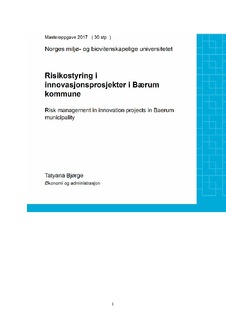| dc.contributor.advisor | Kristiansen, Glenn | |
| dc.contributor.author | Bjørge, Tatyana | |
| dc.coverage.spatial | Norway, Bærum | nb_NO |
| dc.date.accessioned | 2017-11-21T09:27:34Z | |
| dc.date.available | 2017-11-21T09:27:34Z | |
| dc.date.issued | 2017 | |
| dc.identifier.uri | http://hdl.handle.net/11250/2467277 | |
| dc.description.abstract | Studien som ble gjennomført i forbindelse med masteroppgave hadde fokus på risikostyring i innovasjonsprosesser i Bærum kommune. Bærum kommune er et godt studieobjekt på grunn av dens fremragende innsats i innovasjonsarbeidet. I 2016 på Arendalskonferansen ble det tildelt innovasjons pris til Bærum kommune i forbindelse med sine innovasjonsprosjekter i skole- og velferdssektorer (Direktoratet for forvaltning og IKT, 2016).
Hensikten bak denne studien er å undersøke hvordan Bærum kommune håndterer risiko i innovasjonsprosjekter og hvordan de implementerer risikostyring i innovasjonsprosesser. Utgangspunkt ved vurderinger av kommunenes ferdigheter til å håndtere risiko i innovasjonsprosjekter ligger Hillsons (1997) modenhetsmodell. Denne modellen synliggjør fire viktige attributter som er viktige ved vurderinger. Det er risikokultur, risikostyringsprosess, risikostyringsverktøy og kompetanse. Utfra beskrivelsen som gis av Hillson (1997) av hva som kjennetegner disse attributtene i organisasjoner som er dyktige til å håndtere risiko ble det definert elleve tilhørende elementer. Disse attributtene og elementene ligger til grunn i analysen. | nb_NO |
| dc.description.abstract | The study that was carried out in connection with the master's thesis focused on risk management in innovation processes in Bærum municipality. Bærum municipality is a good study subject due to its outstanding efforts in the innovation work. In 2016 at the Arendal conference, the innovation award was awarded to Bærum municipality in connection with its innovation projects in the school and welfare sectors (Directorate for Management and ICT, 2016). The purpose of this study is to investigate how Bærum municipality handles risk in innovation projects and how they implement risk management in innovation processes. Based on assessments of municipalities' ability to handle risk in innovation projects, Hillsons (1997) maturity model is based. This model illustrates four key attributes that are important in assessments. It is risk culture, risk management process, risk management tools and competence. Based on the description given by Hillson (1997) of what characterizes these attributes in organizations that are capable of managing risk, eleven associated elements were defined. These attributes and elements form the basis of the analysis. | nb_NO |
| dc.language.iso | nob | nb_NO |
| dc.publisher | Norwegian University of Life Sciences, Ås | nb_NO |
| dc.rights | Attribution-NonCommercial-NoDerivatives 4.0 Internasjonal | * |
| dc.rights.uri | http://creativecommons.org/licenses/by-nc-nd/4.0/deed.no | * |
| dc.title | Risikostyring i innovasjonsprosjekter i Bærum kommune | nb_NO |
| dc.title.alternative | Risk management in innovation projects in Baerum municipality | nb_NO |
| dc.type | Master thesis | nb_NO |
| dc.description.localcode | M-ØA | nb_NO |

